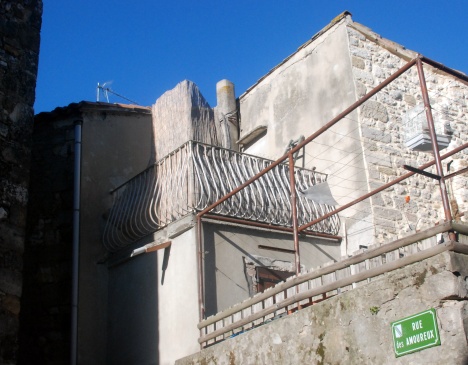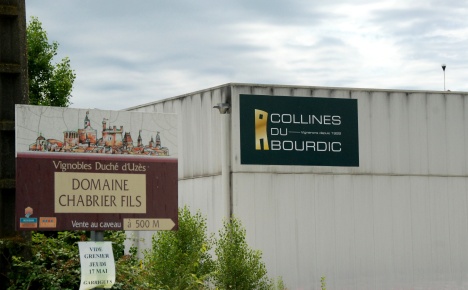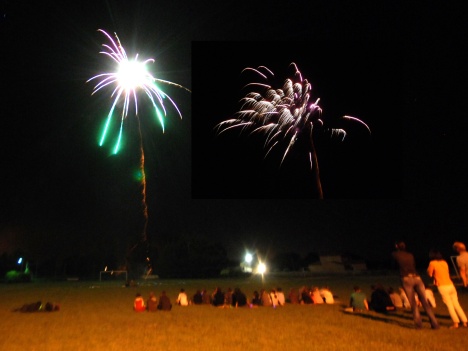Bourdic, a small village in the south of France. A bit sleepy, off the beaten track. It is not even located in the core area of wine, but also a bit away from the famous appellations, in the Département Gard, ten kilometers southeast of Uzès, the medieval town with its ducal palace, the picturesque old town, and its Renaissance mansions. Bourdic has about 300 inhabitants and still has a railway station, but there have been no trains there for 72 years.
 |
| A dreamy village with charm (Photo: P. Züllig) |
The rails have long since been torn up and replaced by vines. There is no village shop, a baker makes the rounds between nine and ten in the morning. The rustic church is dedicated to John the Baptist. Ten years ago, this village - like so many villages in the area - was flooded. The mark is emblazoned man-high (as a reminder) on the village hall, the mairie.
But Bourdic owns two big caves, the cooperative "Les Collines du Bourdic" and the private "Domaine Chabrier Fils", two stately wine-processing companies. Competitors, so to speak. This is also a typical southern French constellation. The wine grower Chabrier, the grandfather of today's Chabriers, was co-founder of the wine cooperative in Bourdic in 1928. His sons were also still active in it. Then - in 1998 - the next generation opened their own wine business, right next to the stately building complex of the cooperative. "C'est par amour du vin qu'ils ont créé leur cave particulière", is written in the family chronicle. They founded their private winery out of love for wine. Not an easy situation in a village with just under 300 inhabitants. The Chabriers' new, independent wine estate comprises 60 hectares with vines not only in Bourdic but also in surrounding communities. There, about 4,000 hectoliters of wine are produced per year.
 |
| The two wine estates of Bourdic - close to each other (photo: P. Züllig) |
The cooperative competition - comprising seven communes - has also undergone a major change in recent years: away from mass production and towards independent wines of greatly improved quality. The area around Uzès did not have an AOC status so far. The freedom was used to plant vines that are not typical for Languedoc, above all Merlot and Cabernet Sauvignon, which can be marketed much better. However, the fight for AOC dignities, which will soon last twenty years, has almost been won by now. The AOC Duché d'Uzès, respectively AOP Duché d'Uzès (Appelllation d'Orgine Protegée, as it is now called), is successively being introduced, and the areas designated for it are now being determined. The first AOP wines - there are still a few - are already on the market.
 |
| Les Collines du Bourdic - winegrowers' cooperative (photo: P. Züllig) |
Both wine companies in Uzès are fighting for AOP recognition of some of their wines. In doing so, the double strategy - which is becoming more and more widespread in Languedoc - cannot be overlooked: on the one hand, offering new products in line with the market (mainstreami grape varieties, special cuvées, etc.), and on the other hand, making traditional wines typical of the region, with grape varieties that, according to AOP regulations, remain the same as under the previous Vin-de-Pays statute. For the reds: Grenache, Syrah, Cinsault, Carignan and Mourvèdre. For the whites: Clairette, Grenache blanc, Marsanne, Rolle (Vermentino), Roussanne, Ugni blanc and Viognier.
The merger with Cave Saint Maximin has created what is probably the largest cooperative in the Département of Gard: "Les Collines du Bourdic, pas une cave coopérative "ordinaire"", not a similar winery, as it defines itself. With an annual production of 140,000 hectoliters of wine, 80 percent of which is commercialized as wine "en vrac" (as open wine), the rest in bottles with very different labels.
There are the small villages, many of them threatened with extinction, mostly only "saved" by selling the houses as second homes to sun-hungry strangers. Villages that are looking for a new identity and - although they are located in the middle of agricultural areas (vineyards, sunflowers, olives, sheep and of course vines) - are moving into completely different areas: Tourism, industry (with long journeys), simply wherever there is still something to be earned.All this sounds so technical-normal. They are facts as they are presented again and again in wine magazines and on wine websites. What fascinates me, however, are the mechanisms hidden behind them, which are usually hardly noticed, even though they are almost omnipresent in the Languedoc region.
But there are also the many wineries, which can only survive in the worldwide wine market by huge investments and larger mergers.
There are also more and more vintners who break away from the traditional cooperatives and open their own wineries with varying success, vinify and market their wines themselves, often developing a new quality awareness.
There is the reorganization of the French wine hierarchy, the vying for the AOC (or AOP) status, the temptation to cultivate mainstream grape varieties, but also to collect considerable runaway premiums, which decisively influence the wine market - as if on invisible threads. In no other wine region have so many vines been uprooted during the past three or four years as in the Languedoc region. But an agricultural alternative has not been found yet.
All this became really clear to me on two occasions in the small village of Bourdic. When, at a house party - a meeting of strangers and locals - I was poured a wine of the Valais grape variety Petite Arvine, but grown in the Languedoc, cultivated by a winegrower in the vicinity; when I was presented with typical Valais wines from the Domaine Chabrier - from a co-production with the Valais winegrower Frédéric Zufferey; when, on the evening of the Quatorze Juillet, the village, as in the past, grouped around the small fireworks display in a festive mood and sang (albeit somewhat hesitantly) not the Marseillaise but "Coupo Santo": "Pour la gloire du pays vous enfin qui êtes consentants nos alliés, Catalans, de loin, ou frères, tous ensemble communion. Coupe sainte et débordante verse à pleins bords, verse à flots les enthousiasmes et l'énergie des forts!"
 |
| Quatorze Julliet - National Day in the village (Photo: P. Züllig) |
A translation? It is hardly possible, nor is it necessary. The traditional song expresses what is felt here: a new self-confidence that has grown in this region - despite all the contradictions and economic interests.
Perhaps one should mingle more often in small Languedoc villages along the Quatorze Julliet or at house parties to understand the importance of wine here.
Sincerely
Yours sincerely